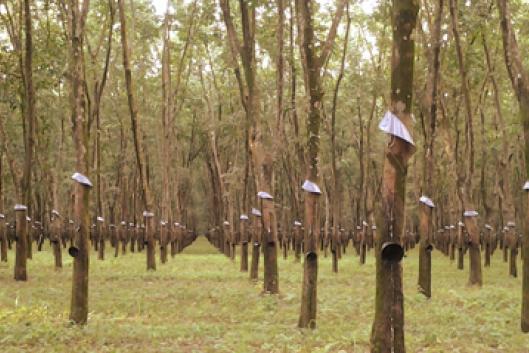Hevea brasilensis, known as the Pará rubber tree or, most commonly, the rubber tree, is native to South America. It is the member of the genus Hevea most frequently exploited industrially, as the milky latex extracted from the tree is the primary source of natural rubber.
Rubber tree cultivation was introduced in Guatemala in 1940 through an initiative of the United States Department of Agriculture. Fifteen years later, the first census of plantations in the country reported some 10,000 hectares of rubber trees. In 2003, that area had increased to 52,000 hectares. By 2012, there were over 100,000 hectares of rubber tree plantations, located primarily in the departments of Retalhuleu and Suchitepéquez, on Guatemala’s southern coast. Of these, 55,000 hectares were occupied by trees in the productive phase while the other 45,000 hectares of trees were still immature.
According to a map of “Areas suitable for the development of rubber tree cultivation” prepared by the Ministry of Agriculture and Livestock of Guatemala, there are more than 400,000 hectares of land in the country suited to growing rubber trees. The areas identified are located in the so-called Northern Transversal Strip and on the southern coast of the country, in addition to parts of the departments of Izabal and Alta Verapaz. However, the expansion of rubber tree plantations based on these projections should be subject to serious analysis and reflection, particularly because of competition with other land uses and the land grabbing that could be driven by the growth of these industrial plantations, in a country where there are already high levels of conflict over land access and tenure.
An erroneous concept spread by the promoters of rubber tree plantations is that these constitute planted “forests”. In fact, tree plantations cannot be compared to actual forests, with their wealth of biological diversity and complex interactions. In most cases, plantations are established in accordance with a market-based logic, which means the lives of these plantations are also regulated by international prices and demand.
Guatemala is one of the main producers and exporters of natural rubber in the Americas. The environmental and social impact that could result from the expansion of rubber tree plantations is another factor that must be considered if the areas to be planted with these trees are currently areas with forest cover, which is at risk of being destroyed, since during the preparation of land for the planting of rubber trees, “trees and shrubs must be eliminated because the growth of Hevea requires full exposure to sunlight,” according to the National Coffee Association in its 2004 report, “Cultivo de Hule” (Rubber Tree Cultivation).
Rubber tree cultivation can also be used to take advantage of the carbon market, where these plantations could sell “credits” for the carbon they absorb and store, providing yet another business opportunity for the rubber tree plantation owners. But this trade mechanism is criticized by environmental groups because it does not represent a genuine solution to the climate crisis, since it does not contribute to reducing the pollution generated by the current productive practices of companies.
In 2010, the first international sale of carbon credits from rubber tree plantations was announced by the Guatemalan company Grupo Agroindustrial de Occidente (GAO), and involved the establishment of 2,500 hectares of new plantations. According to the newspaper El Periódico, in an article published on June 10, 2010, an agreement for the purchase of “verified emissions reductions” was signed between the Swiss firm FirstClimate and the GAO subsidiary Pica de Hule Natural, S.A. The agreement was signed during the Carbon Expo international trade fair and conference, which was held in Cologne, Germany in 2010. The deal will give the Guatemalan business group access to sources of financing from international incentives that promote reforestation and allegedly “contribute to the reduction of climate change,” according to the article.
Developments like these raise serious concerns over the social and environmental impacts that could result from the expansion of rubber tree plantations onto thousands of hectares of new lands. It is also troubling that the country continues to promote a model based on land use for production geared to export, as opposed to more environmentally just land use practices geared to promoting the peasant farming economy, crop diversification and agro-ecology.
Carlos Salvatierra, SAVIA, focal point of the Latin America Network against Tree Plantations (RECOMA) in Guatemala, email salvatierraleal@gmail.com
